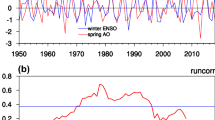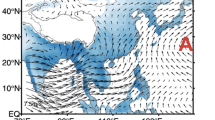Abstract
The western North Pacific anticyclone (WNPAC) is the key bridge that connects El Niño to the East Asian climate anomalies. The persistence and breakdown of the WNPAC has important implications for climate prediction. Our results show that the eastern Pacific (EP) El Niño-induced WNPAC has good persistence in spring, whereas the central Pacific (CP) El Niño-induced WNPAC has an obvious breakdown in spring. The physical mechanisms behind this discrepancy are explored. During the EP El Niño spring, there are strong negative sea surface temperature anomalies (SSTAs) over the western North Pacific (WNP) and strong positive SSTAs over the EP. The negative WNP SSTAs suppress the convection over the WNP and then generate the WNPAC as a Rossby wave response. The positive EP SSTAs also cause suppressed convection over the western Pacific via the anomalous Walker circulation and then yield a WNPAC. In contrast, for the CP El Niño, the local air–sea positive feedback between the WNP SST cooling and the WNPAC in the CP El Niño winter is much weaker than in the EP El Niño winter, leading to the quick decay and disappearance of the WNP SST cooling in spring, which interrupts the WNPAC formation. In addition, with the westward shift of the SST warming to the central Pacific, the induced suppressed convection via the anomalous Walker circulation correspondingly moves westward around the Philippines, not around the western Pacific, which is not in favor of generating a remarkable WNPAC. Thus, a breakdown of the WNPAC is often observed for CP El Niño spring.













Similar content being viewed by others
Availability of data and material
The JRA-55 data used in this research can be accessed from https://climatedataguide.ucar.edu/climate-data/jra-55. The HadISST dataset is obtained from http://badc.nerc.ac.uk/view/badc.nerc.ac.uk__ATOM__dataent_hadisst.
References
Ashok K, Behera SK, Rao SA, Weng H, Yamagata T (2007) El Niño Modoki and its possible teleconnection. J Geophys Res Ocean 112:C11007
Bao Q, Lin P, Zhou T et al (2013) The flexible global ocean-atmosphere-land system model, spectral version 2: FGOALS-s2. Adv Atmos Sci 30:561–576. https://doi.org/10.1007/s00376-012-2113-9
Chang CP, Zhang Y, Li T (2000) Interannual and interdecadal variations of the East Asian summer monsoon and tropical pacific SSTs. Part II: Meridional structure of the monsoon. J Clim 13:4326–4340. https://doi.org/10.1175/1520-0442(2000)013%3c4326:IAIVOT%3e2.0.CO;2
Chen J, Wang X, Zhou W, Wang CZ, Xie Q, Li G, Chen S (2018) Unusual Rainfall in Southern China in decaying august during extreme El Niño 2015/16: role of the Western Indian Ocean and north tropical Atlantic SST. J Clim 31:7019–7034. https://doi.org/10.1175/JCLI-D-17-0827.1
Chen M, Yu JY, Wang X, Jiang W (2019) The changing impact mechanisms of a diverse El Niño on the Western Pacific Subtropical High. Geophys Res Lett 46:953–962. https://doi.org/10.1029/2018GL081131
Chen J, Yu JY, Wang X, Lian T (2020) Different influences of southeastern Indian Ocean and western Indian Ocean SST anomalies on eastern China rainfall during the decaying summer of the 2015/16 extreme El Niño. J Clim 33:5427–5443. https://doi.org/10.1175/JCLI-D-19-0777.1
Chikamoto Y, Tanimoto Y (2006) Air-sea humidity effects on the generation of tropical Atlantic SST anomalies during the ENSO events. Geophys Res Lett. https://doi.org/10.1029/2006GL027238
Du Y, Xie SP, Huang G, Hu K (2009) Role of air-sea interaction in the long persistence of El Niño-induced north Indian Ocean warming. J Clim 22:2023–2038
Enfield DB, Mayer DA (1997) Tropical atlantic sea surface temperature variability and its relation to El Niño-Southern Oscillation. J Geophys Res 102:929–945
Feng J, Li J (2011) Influence of El Nino Modoki on spring rainfall over south China. J Geophys Res Atmos 116:D13102
Feng J, Wang L, Chen W, Fong SK, Leong KC (2010) Different impacts of two types of Pacific Ocean warming on Southeast Asian rainfall during boreal winter. J Geophys Res Atmos. https://doi.org/10.1029/2010JD014761
Feng J, Chen W, Tam CY, Zhou W (2011) Different impacts of El Niño and El Niño Modoki on China rainfall in the decaying phases. Int J Climatol 31:2091–2101
Feng J, Wang L, Chen W (2014) How does the east asian summer monsoon behave in the decaying phase of El Niño during different PDO phases. J Clim 27:2682–2698
Feng J, Chen W, Li Y (2017) Asymmetry of the winter extra-tropical teleconnections in the Northern Hemisphere associated with two types of ENSO. Clim Dyn 48:2135–2151
Feng J, Chen W, Wang X (2020) Reintensification of the Anomalous Western North Pacific Anticyclone during the El Niño Modoki decaying summer: relative importance of Tropical Atlantic and Pacific SST Anomalies. J Clim 33:3271–3288. https://doi.org/10.1175/JCLI-D-19-0154.1
Ham YG, Kug JS (2012) How well do current climate models simulate two types of El Nino? Clim Dyn 39:383–398. https://doi.org/10.1007/s00382-011-1157-3
Ham YG, Kug JS, Park JY, Jin FF (2013) Sea surface temperature in the north tropical Atlantic as a trigger for El Niño/Southern Oscillation events. Nat Geosci 6:112–116
Huang R, Zhou L, Chen W (2003) The progresses of recent studies on the variabilities of the East Asian monsoon and their causes. Adv Atmos Sci 20:55–69. https://doi.org/10.1007/BF03342050
Kao HY, Yu JY (2009) Contrasting Eastern-Pacific and Central-Pacific types of ENSO. J Clim 22:615–632. https://doi.org/10.1175/2008JCLI2309.1
Karori MA, Li Dr J, Jin FF (2013) The asymmetric influence of the two types of El Niño and La Niña on summer rainfall over Southeast China. J Clim 26:4567–4582
Kim JW, Chang TH, Lee CT, Yu JY (2021) On the varying responses of East Asian winter monsoon to three types of El Niño: observations and model hindcasts. J Clim 34:4089–4101. https://doi.org/10.1175/jcli-d-20-0784.1
Klein SA, Soden BJ, Lau NC (1999) Remote sea surface temperature variations during ENSO: evidence for a tropical atmospheric bridge. J Clim 12:917–932. https://doi.org/10.1175/1520-0442(1999)012%3c0917:RSSTVD%3e2.0.CO;2
Kobayashi S, Ota Y, Harada Y et al (2015) The JRA-55 reanalysis: general specifications and basic characteristics. J Meteorol Soc Japan 93:5–48. https://doi.org/10.2151/jmsj.2015-001
Kug JS, Jin FF, Il AS (2009) Two types of El Niño events: cold tongue El Niño and warm pool El Niño. J Clim 22:1499–1515. https://doi.org/10.1175/2008JCLI2624.1
Larkin NK, Harrison DE (2005) Global seasonal temperature and precipitation anomalies during El Niño autumn and winter. Geophys Res Lett 32:1–4
Li T, Wang B, Wu B, Zhou TJ, Chang CP, Zhang RH (2017) Theories on formation of an anomalous anticyclone in western North Pacific during El Niño: a review. J Meteorol Res 31:987–1006
Ma S, Zhu C, Liu J (2020) Combined impacts of warm central equatorial Pacific Sea surface temperatures and anthropogenic warming on the 2019 severe drought in East China. Adv Atmos Sci 37:1149–1163. https://doi.org/10.1007/s00376-020-0077-8
Paek H, Yu JY, Hwu JW et al (2015) A source of AGCM bias in simulating the western Pacific subtropical high: different sensitivities to the two types of ENSO. Mon Weather Rev 143:2348–2362. https://doi.org/10.1175/MWR-D-14-00401.1
Rayner NA, Parker DE, Horton EB et al (2003) Global analyses of sea surface temperature, sea ice, and night marine air temperature since the late nineteenth century. J Geophys Res Atmos. https://doi.org/10.1029/2002jd002670
Rong XY, Zhang RH, Li T (2010) Impacts of Atlantic sea surface temperature anomalies on Indo-East Asian summer monsoon-ENSO relationship. Chinese Sci Bull 55:2458–2468. https://doi.org/10.1007/s11434-010-3098-3
Su JZ, Zhang RH, Zhu CW (2013) ECHAM5-simulated impacts of two types of El Niño on the winter precipitation Anomalies in South China. Atmos Ocean Sci Lett 6:360–364
Wang C, Wang X (2013) Classifying El Niño Modoki I and II by different impacts on rainfall in southern China and typhoon tracks. J Clim 26:1322–1338. https://doi.org/10.1175/JCLI-D-12-00107.1
Wang B, Zhang Q (2002) Pacific-East Asian teleconnection. Part II: How the Philippine Sea anomalous anticyclone is established during El Niño development. J Clim 15:3252–3265
Wang B, Wu R, Fu X (2000) Pacific-East Asian teleconnection: How does ENSO affect East Asian climate? J Clim 13:1517–1536. https://doi.org/10.1175/1520-0442(2000)013%3c1517:PEATHD%3e2.0.CO;2
Wang B, Wu R, Li T (2003) Atmosphere—Warm Ocean interaction and its impacts on Asian—Australian monsoon variation. J Clim 16:1195–1211. https://doi.org/10.1175/1520-0442(2003)16%3c1195
Wang B, Xiang B, Lee JY (2013a) Subtropical High predictability establishes a promising way for monsoon and tropical storm predictions. Proc Natl Acad Sci USA 110:2718–2722. https://doi.org/10.1073/pnas.1214626110
Wang X, Liu Y, Wu G et al (2013b) The application of flux-form semi-Lagrangian transport scheme in a spectral atmosphere model. Adv Atmos Sci 30:89–100. https://doi.org/10.1007/s00376-012-2039-2
Wang B, Lee JY, Xiang B (2014) Asian summer monsoon rainfall predictability: a predictable mode analysis. Clim Dyn 44:61–74. https://doi.org/10.1007/s00382-014-2218-1
Wang X, Tan W, Wang C (2018) A new index for identifying different types of El Niño Modoki events. Clim Dyn 50:2753–2765. https://doi.org/10.1007/s00382-017-3769-8
Weng H, Ashok K, Behera SK et al (2007) Impacts of recent El Niño Modoki on dry/wet conditions in the Pacific rim during boreal summer. Clim Dyn 29:113–129
Weng H, Behera SK, Yamagata T (2009) Anomalous winter climate conditions in the Pacific rim during recent El Niño Modoki and El Niño events. Clim Dyn 32:663–674
Wu R, Hu ZZ, Kirtman BP (2003) Evolution of ENSO-related rainfall anomalies in East Asia. J Clim 16:3742–3758. https://doi.org/10.1175/1520-0442(2003)016%3c3742:EOERAI%3e2.0.CO;2
Wu B, Zhou T, Li T (2009) Seasonally evolving dominant interannual variability modes of East Asian climate. J Clim 22:2992–3005. https://doi.org/10.1175/2008JCLI2710.1
Wu B, Li T, Zhou T (2010) Relative contributions of the Indian Ocean and local SST anomalies to the maintenance of the western North pacific anomalous anticyclone during the El Niño decaying summer. J Clim 23:2974–2986
Xie SP, Hu K, Hafner J et al (2009) Indian Ocean capacitor effect on Indo-Western pacific climate during the summer following El Niño. J Clim 22:730–747
Xu K, Tam CY, Zhu C et al (2017) CMIP5 projections of two types of El Niño and their related tropical precipitation in the Twenty-First Century. J Clim 30:849–864
Yeh SW, Kug JS, Dewitte B et al (2009) El Nĩo in a changing climate. Nature 461:511–514. https://doi.org/10.1038/nature08316
Yu JY, Zou Y, Kim ST, Lee T (2012) The changing impact of El Nio on US winter temperatures. Geophys Res Lett. https://doi.org/10.1029/2012GL052483
Yu JY, Kao PK, Paek H et al (2015) Linking emergence of the central Pacific El Niño to the Atlantic multidecadal oscillation. J Clim 28:651–662
Yu JY, Wang X, Yang S et al (2017) Changing El Nino-Southern oscillation and associated climate extremes, book chapter in climate extremes: patterns and mechanisms. AGU Geophys Monogr Ser 226:3–38
Yu T, Feng J, Chen W (2019) Linear respective roles of El Niño-Southern Oscillation and East Asian winter monsoon in the formation of the western North Pacific anticyclone. Int J Climatol 39:3257–3270. https://doi.org/10.1002/joc.6016
Yuan Y, Yang S (2012) Impacts of different types of El NiñO on the East Asian climate: focus on ENSO cycles. J Clim 25:7702–7722
Zhang R, Sumi A (2002) Moisture circulation over East Asia during El Niño episode in northern winter, spring and autumn. J Meteorol Soc Japan 80:213–227
Zhang R, Akimasa S, Masahide K (1999) A Diagnostic Study of the impact of El Niño on the precipitation in China. Adv Atmos Sci 16:229–241
Zhang RH, Min QY, Su JZ (2017) Impact of El Niño on atmospheric circulations over East Asia and rainfall in China: Role of the anomalous western North Pacific anticyclone. Sci China Earth Sci 60:1124–1132
Zhou LT, Wu R (2010) Respective impacts of the East Asian winter monsoon and ENSO on winter rainfall in China. J Geophys Res Atmos. https://doi.org/10.1029/2009JD012502
Funding
This study was supported jointly by the National Key Research and Development Program (Grant No. 2016YFA0600604) and the Key Research Program of Frontier Sciences, CAS (QYZDY-SSW-DQC024).
Author information
Authors and Affiliations
Contributions
Conceptualization: TY, WC, JF; Formal analysis: TY, JF; Investigation: JF; Methodology: TY, JF, XW; Supervision: WC; Writing—original draft: TY.
Corresponding author
Ethics declarations
Conflict of interest
The authors have no relevant financial or non-financial interests to disclose.
Additional information
Publisher's Note
Springer Nature remains neutral with regard to jurisdictional claims in published maps and institutional affiliations.
Rights and permissions
About this article
Cite this article
Yu, T., Feng, J., Chen, W. et al. Persistence and breakdown of the western North Pacific anomalous anticyclone during the EP and CP El Niño decaying spring. Clim Dyn 57, 3529–3544 (2021). https://doi.org/10.1007/s00382-021-05882-x
Received:
Accepted:
Published:
Issue Date:
DOI: https://doi.org/10.1007/s00382-021-05882-x




